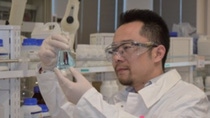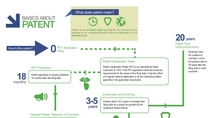Protect innovations in China
“How should researchers work with the IP team? Why do we need legal support for patent preparation in China? Would it not make more sense if we rely on the existing resources in Europe?” On a recent meeting, researchers from Innovation Campus Asia Pacific (Shanghai) asked these questions during a discussion on intellectual property and research innovations.
To Dr. Harald Lauke, President, Advanced Materials & Systems Research, Regional Research Representative for Asia Pacific, BASF, the relationship between intellectual property protection and R&D innovations is obvious: “IP protection is important, independent of where the invention was done.” Along with the increasing research and development activities in Asia Pacific, the local competence of IP regarding patent preparation needs to be further developed and matured Researchers in Asia Pacific should acquire basic skills and knowhow related to how to prepare patent, with professional support from IP team.
.jpg)
“IP protection is important, independent of where the invention was done.”
Dr. Harald Lauke, President, Advanced Materials & Systems Research, Regional Research Representative for Asia Pacific, BASF
Liu Xia, head of Intellectual Property in China, officially joined the R&D Leadership Team Shanghai. With more than 10 years of experience as IP counsel at BASF. Liu has been leading a team of IP attorneys since April, 2016. They work in Shanghai and Beijing, supporting various research and business units on all IP related matters, including drafting, prosecuting patent applications globally for the inventions made in China and maintaining the existing patents.
As introduced by Liu, each patent attorney in China covers several business units and broad technical fields, which is different from the setup in Europe where each attorney takes care of a specific technical field. To ensure quality service, IP in the region is largely supported by the global intellectual property team in Europe via various means.
The number of patents is one of the key indicators for the innovativeness of a research organization. From 2012, when Innovation Campus Asia Pacific (Shanghai) was inaugurated, Patent Cooperation Treaty1 applications on local innovations have risen each year.
China's strategy is changing from "Made in China" to "Created in China”. It represents an enormous number of opportunities for BASF, to provide solutions for less energy consumption, cleaner air and water, and higher standard of living. “We should capture these opportunities and turn our inventions in our labs into innovations on the market,” said Lauke.
The PCT application on formaldehyde abatement dispersion for interior decorative paints developed by Dispersion and Colloidal Material Research Team at BASF Innovation Campus Asia Pacific(Shanghai) was successfully filed in 2014. This dispersion is used as one of the main components for interior decorative paints. It can permanently remove up to 90% of the free formaldehyde within a day. It also has excellent anti-yellowing properties.

Looking back the patent application preparation, Dr. Zeng Zhong, the technical person-in-charge, said, “The IP team provided support throughout the entire preparation process.” Since the patent landscape analysis at early research process, the IP team and the research team has been working closely with each other. Dr. Zeng shared his most impressive moment, “During the PCT application preparation, to have the patent granted with the broadest protection scope, we communicated for a number of times, from supplementary data to even use of a single terminology. The professional and responsible work from the IP team has provided the strongest support in the patent protection of this invention.” “We encourage researchers to involve us in their research projects as early as possible, so as to evaluate whether a patent should be filed in a timely manner, to prepare along the way for patent applications and to strengthen the awareness of IP protection for our researchers.” said Liu.
Dr. Zeng regards IP related knowledge as a must-have quality for each researcher. “Whenever it is in patent preparation or daily research work, researchers should keep close communication with the IP team, so as to identify potential patent application opportunities or avoid latent IP infringement risks.”
Except for professional services provided by the IP team, two training courses related to IP are provided via BASF human resources platform. One is the basic IP training which covers a broad field of basic knowledge including patent, trademark, copyright, and trade secret, etc. The other one is the advanced training on patent, which offers a deep dive on the patent related knowledge.
According to the statistics released by the State Intellectual Property Office of China in April 2017, 1.339 million patent applications for invention were submitted in the country in 2016, an increase of 21.5% over the year previous. Over 40,000 PCT patent applications were received, and the number of Chinese valid patents for invention was more than 1 million.
“People would think that IP protection is very challenging in China, where Shanzhai (mass produced imitation goods) still flourishes on the market,” said Liu, “In recent years, there is an increase in IP awareness and the IP protection develops rapidly in China. IP owners are more confident and willing to seek protection through legal processes. For example, according to the White Paper on Intellectual Property Protection by Chinese Courts (2016), Chinese courts accepted152,072 various IP cases of first instance in 2016. The number represented a 16.8% year-on-year increase, of which civil IP cases of first instance saw a significant increase, up 24.82% year-on-year.”
The Chinese government is now strengthening the protection of IP, optimizing IP services and promoting the overall development of the IP. In 2014, specialized IP courts were set up in Beijing, Shanghai and Guangzhou. In 2015, General Office of the State Council forwarded the Action Plan for Further Implementation of the National IP Strategy (2014-2020) that clearly defined the guiding thoughts, main goals and action steps of the implementation of the National Intellectual Property Strategy during the following period. The Action Plan indicates, by 2020, China will significantly increase the level of IPR creation. The State Intellectual Property Office (formerly known as Chinese Patent Office) is one of the five biggest patent offices in the world, and enjoys good reputation regarding the quality of patent examination.
How effectively BASF and other international companies can protect their IP against competitors in China, is a most interesting question among researchers.
“We have been helping protect our local business with established expertise in IP protection. For instance, in the Crop Protection market in China, BASF has been actively enforcing IP rights.” said Liu. Since 2009, BASF has been initiating IP protection actions at international pesticides exhibitions by demanding exhibitors who infringed on IP rights of BASF to remove relevant materials. In 2014 and 2015, BASF legally pressed charges against three exhibitors for patent infringements. The court has justly ruled in favor of BASF in all cases.
Nevertheless, challenges still exist especially in IP enforcement. For instance, evidence collection is difficult and costly, the damage compensation is discouragingly low, and execution of the ruling is troublesome. “We are in the hope that China will eventually harmonize its IP laws with international IP laws, and facilitate enforcement to foster a business environment that provides the necessary assurance to enable world-class innovation in China,” said Lauke.
PCT is abbreviation of Patent Cooperation Treaty. It is an international treaty on patent. PCT allows applicants to submit patent applications through PCT to multiple countries.
